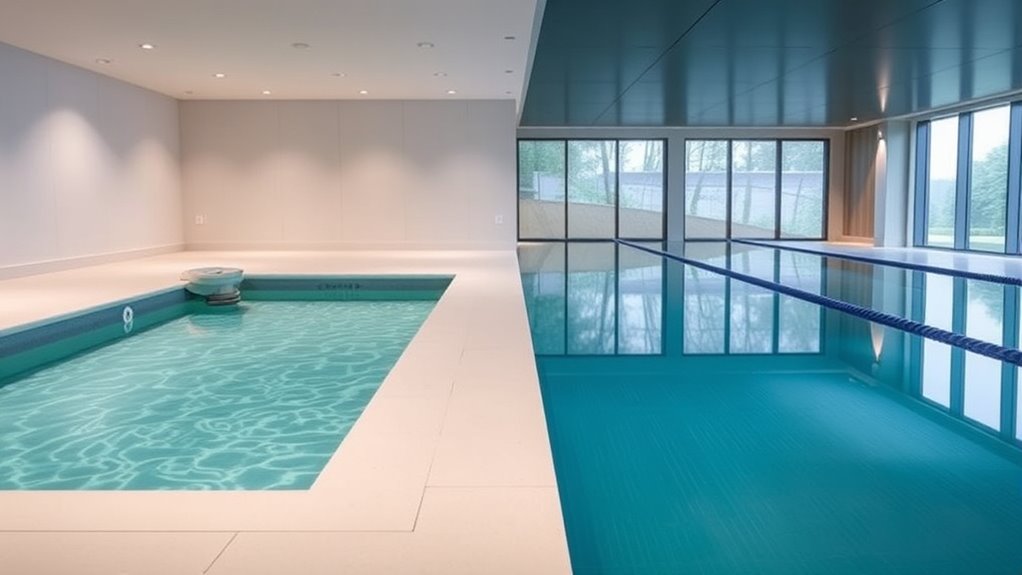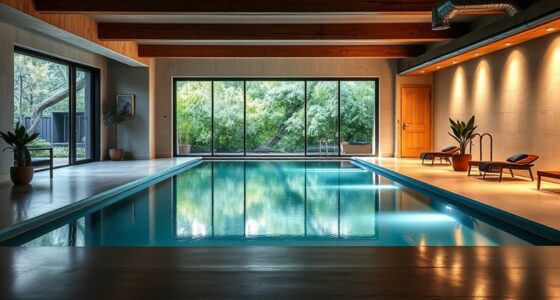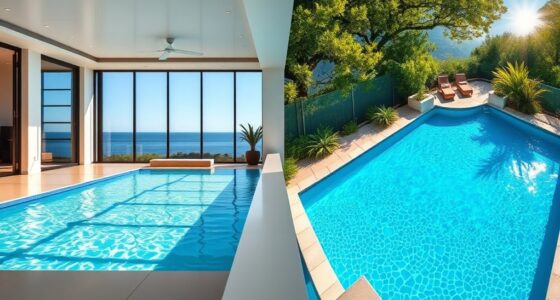Choosing between an endless pool and a lap pool depends on your space, budget, and fitness goals. If you have limited space and want quick, versatile workouts, an endless pool is a great fit thanks to its compact design and low maintenance. For dedicated swimmers seeking longer distances and endurance training, a lap pool offers more room but requires more space and investment. To find the best option for your lifestyle, explore the detailed differences below.
Key Takeaways
- Endless pools are compact and ideal for small indoor or outdoor spaces, while lap pools require longer, narrow areas for continuous swimming.
- Endless pools offer versatile workouts and quick installation, suitable for busy lifestyles and limited spaces.
- Lap pools are better for endurance training and longer swim sessions, often demanding more space and permanent installation.
- Cost-wise, endless pools typically have lower initial and maintenance expenses compared to larger lap pools.
- Choose an endless pool for convenience and versatility; opt for a lap pool if dedicated swimming space and endurance training are priorities.
Understanding the Basic Designs of Endless and Lap Pools
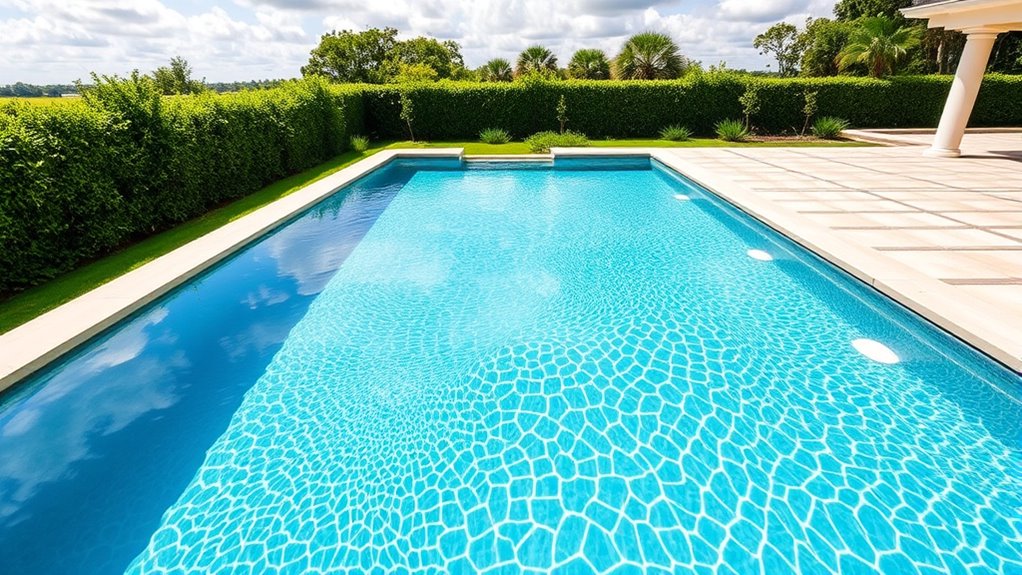
While both endless pools and lap pools are designed for swimming, their basic structures differ markedly. An endless pool is a compact, integrated system featuring a built-in counter-current jet that creates a continuous current, allowing you to swim in place. It’s usually installed indoors or outdoors in smaller spaces. In contrast, a lap pool is a traditional, elongated rectangular pool built into your yard or facility, designed for swimming laps back and forth. It’s typically deeper and longer, providing a space for continuous swimming over distances. The endless pool emphasizes convenience and space efficiency, while the lap pool offers more traditional swimming conditions. Understanding these fundamental design differences helps you determine which fits your goals and available space best. Additionally, the contrast ratio of each pool’s design can influence how well you see details in different lighting conditions, affecting your swimming experience.
Space Requirements and Installation Considerations
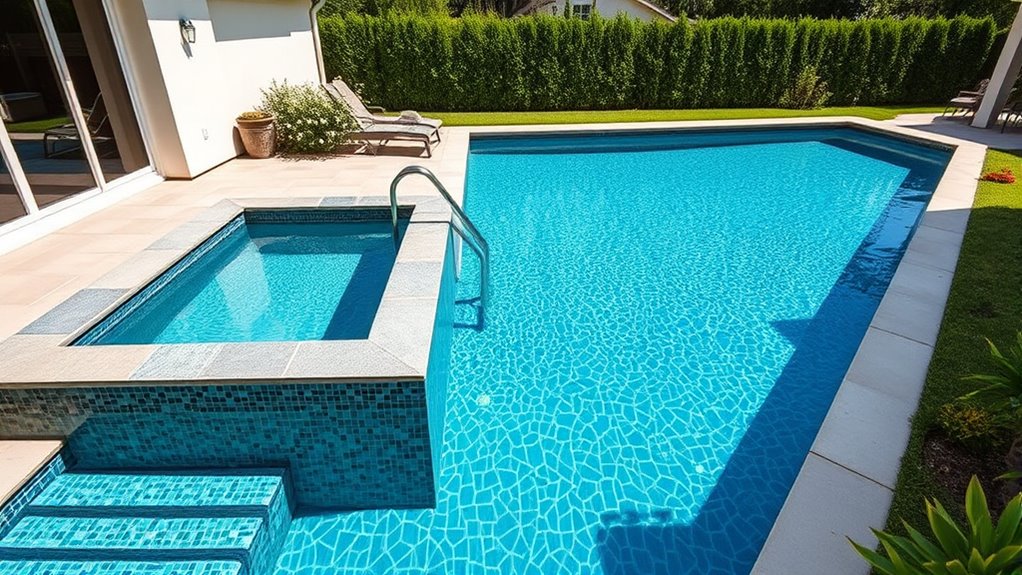
Choosing between an endless pool and a lap pool often depends on your available space and installation flexibility. An endless pool is compact, fitting into smaller areas like basements, garages, or patios, making it ideal if space is limited. Its self-contained design allows for quick installation, often requiring minimal site modifications. In contrast, a lap pool usually needs a larger footprint, such as a backyard or spacious indoors, especially if you want a full-length lane. Installing a lap pool may involve extensive excavation, proper drainage, and structural reinforcement, particularly for in-ground models. Above-ground lap pools are options if you seek easier installation and less permanent setup. Consider your space constraints and how much effort you’re willing to invest in installation when choosing between the two. Proper planning can help mitigate the risks associated with installation challenges and ensure your pool functions safely and efficiently.]
Cost Comparison and Budgeting Tips

Understanding the costs involved helps you plan your pool investment wisely. You’ll want to compare initial purchase prices, ongoing maintenance, and operating expenses to see what fits your budget. We’ll also share tips on financing options to make your dream pool more affordable. Additionally, researching grocery savings strategies can offer valuable insights into cost reduction techniques that might be applicable to budgeting for your pool project.
Initial Purchase Expenses
The initial cost of installing an endless pool typically ranges from $20,000 to $40,000, whereas a traditional lap pool can start around $25,000 and go much higher depending on size and features. To manage your budget wisely, consider these factors:
- Size and Features – Larger pools with advanced features increase costs.
- Installation Complexity – Custom installations or limited space can add expenses.
- Additional Equipment – Heating, covers, or automation systems raise upfront costs.
Endless pools are usually more compact, which can lower initial expenses, but premium features can push prices upward. Traditional lap pools often require more space and excavation, impacting your budget. Evaluate your space, desired features, and long-term goals before making a decision. Proper budgeting guarantees your investment aligns with your needs.
Maintenance and Operating Costs
Maintenance and operating costs can substantially impact your overall investment, and they vary between endless pools and traditional lap pools. Endless pools typically have lower ongoing costs because they use smaller volumes of water and energy-efficient systems, reducing electricity and filtration expenses. Regular servicing involves cleaning filters, checking water chemistry, and inspecting the equipment, which is generally straightforward and less costly. Traditional lap pools, on the other hand, require larger amounts of water, more frequent cleaning, and higher energy use for heating and filtration. Additionally, their larger size means more chemicals and maintenance supplies. To keep costs manageable, consider the pool’s size, the expected frequency of use, and the efficiency of your equipment. Proper upkeep ensures longevity and helps prevent costly repairs down the line. Energy efficiency features in pool equipment can significantly influence long-term operational expenses.
Budgeting and Financing Tips
When planning your pool purchase, comparing costs and creating a realistic budget are essential steps to avoid surprises. To do this effectively:
- Research upfront costs like purchase price, installation, and potential upgrades.
- Factor in ongoing expenses such as maintenance, chemicals, and energy bills.
- Explore financing options like loans or payment plans to spread out costs comfortably.
- Incorporate budget-friendly decor ideas to enhance your pool area without overspending.
Setting a clear budget helps you prioritize features and avoid overspending. Consider obtaining multiple quotes from suppliers and contractors to compare prices. Also, check for financing plans that fit your financial situation, ensuring your dream pool remains affordable. Being thorough upfront prevents unexpected expenses and keeps your project on track, so you can enjoy your new pool without financial stress.
Fitness and Exercise Capabilities
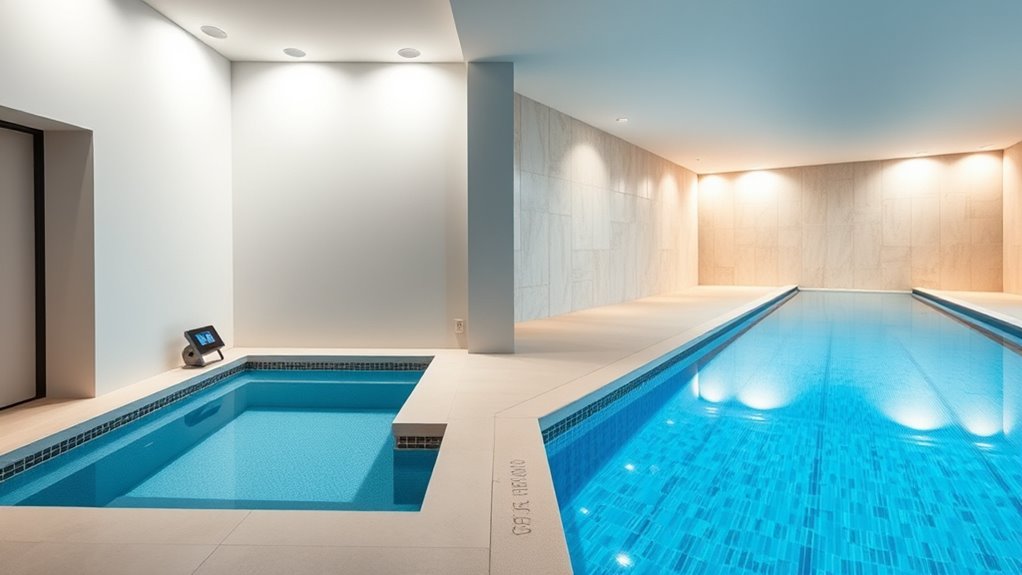
While both endless pools and lap pools offer excellent opportunities for fitness and exercise, they serve slightly different needs when it comes to workout capabilities. An endless pool is highly versatile, allowing you to perform low-impact cardio, resistance training, and water aerobics in a compact space. Its adjustable current lets you easily modify your workout intensity, making it suitable for all fitness levels. Additionally, Volkswagen Tuning techniques can optimize water flow and resistance in the pool, enhancing your training experience. Conversely, a lap pool is ideal if your goal is to focus on endurance, swimming laps, or structured training routines. It provides a longer, uninterrupted stretch of water perfect for sustained swimming sessions. Both options support your fitness goals, but your choice should depend on whether you prioritize varied, versatile workouts or dedicated swim training for endurance.
Maintenance and Operational Expenses
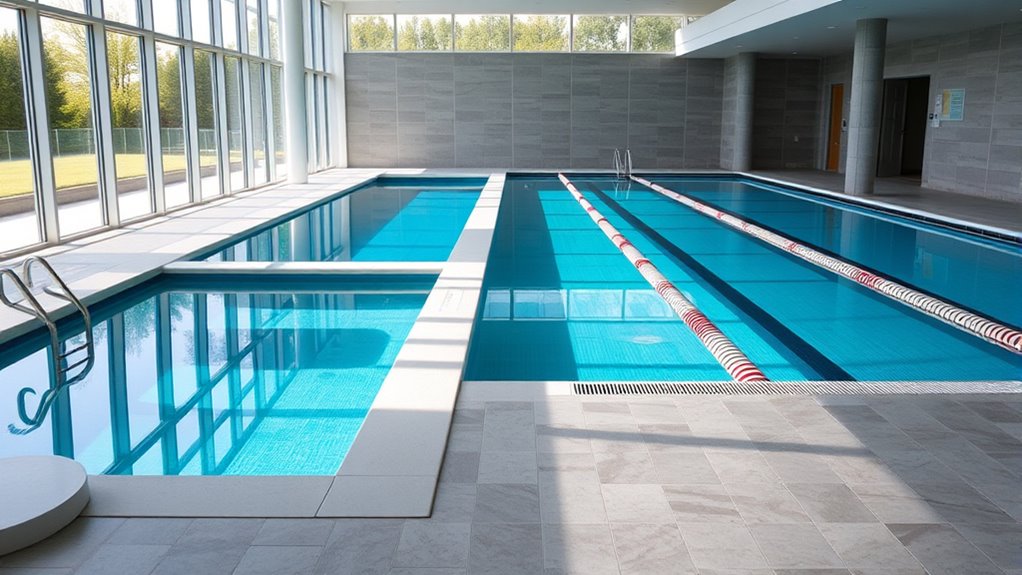
Maintaining and operating an endless pool generally costs less over time because its compact design requires fewer chemicals, less energy, and simpler filtration systems. You’ll spend less on water treatment since smaller volumes need fewer sanitizers. Energy costs decrease because the pump and heater work less to heat and circulate a smaller space. Additionally, the filtration system is simpler, reducing maintenance and replacement parts. As modern innovations focus on sustainable practices, these pools often incorporate environmentally friendly components that further reduce operational costs. Here’s what to contemplate:
- Chemical expenses: Smaller volumes mean fewer chemicals to keep the water balanced.
- Energy consumption: Reduced pump and heater use lowers electricity bills.
- Maintenance simplicity: Fewer components mean easier upkeep and fewer repairs.
Aesthetic Appeal and Customization Options
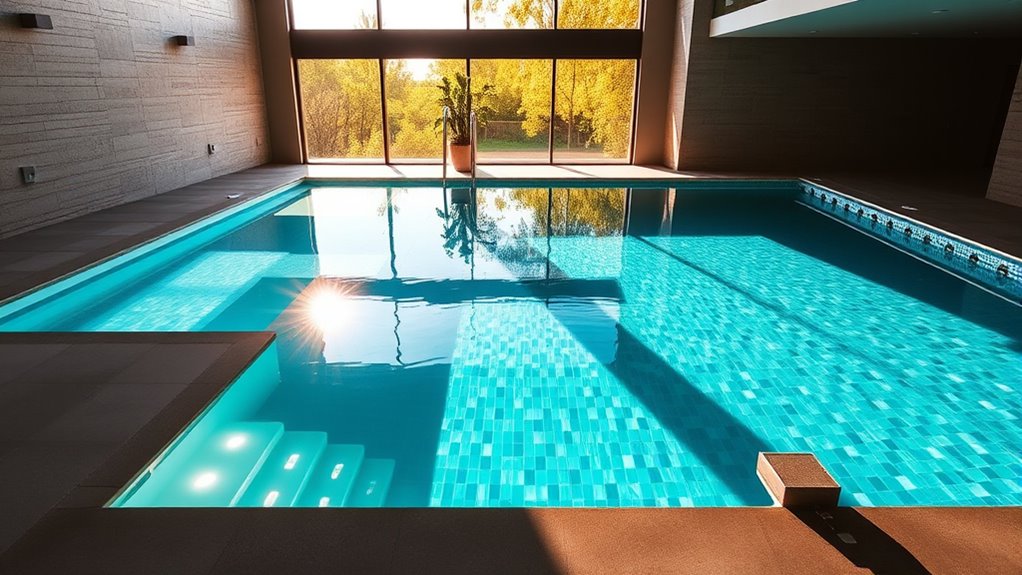
Because endless pools are smaller and more streamlined, they often offer greater flexibility in design and personalization. You can choose from a variety of colors, finishes, and lighting options to match your style and space. Many models allow for custom decking or surrounding areas, enhancing their visual appeal. Endless pools also often feature sleek, modern designs that integrate smoothly into indoor or outdoor environments. Additionally, some manufacturers offer customizable features like built-in benches, underwater speakers, or temperature controls, giving you control over your swimming experience. In contrast, lap pools tend to have a more utilitarian look, though they can be customized with different materials and finishes. Overall, endless pools provide a more versatile and visually appealing option for those seeking a personalized aesthetic. Design flexibility allows homeowners to create a unique and harmonious backyard or indoor space that complements their home’s style.
Ideal Users and Lifestyle Compatibility
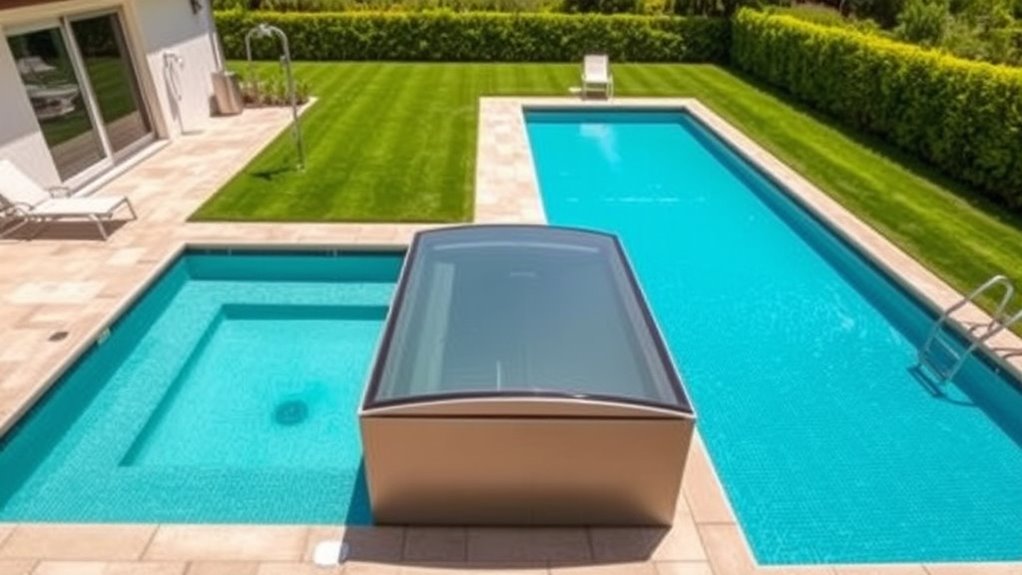
Endless pools are ideal for individuals who want convenient, low-maintenance access to swimming without dedicating large amounts of space or time. If you value quick workouts, space efficiency, and easy upkeep, this option suits your lifestyle. Consider these types of users:
- Busy professionals who need a quick, effective way to stay fit.
- Small households with limited outdoor or indoor space.
- Seniors or those with mobility concerns seeking gentle exercise options.
- People interested in tuning their pools for better performance and efficiency.
Endless pools fit well into compact environments, making regular swimming accessible without extensive planning. They’re perfect if your main goal is consistent exercise and relaxation without the hassle of a traditional pool’s size and maintenance demands. This pool type aligns with a fast-paced, space-conscious, or low-maintenance lifestyle.
Making the Final Decision Based on Your Needs
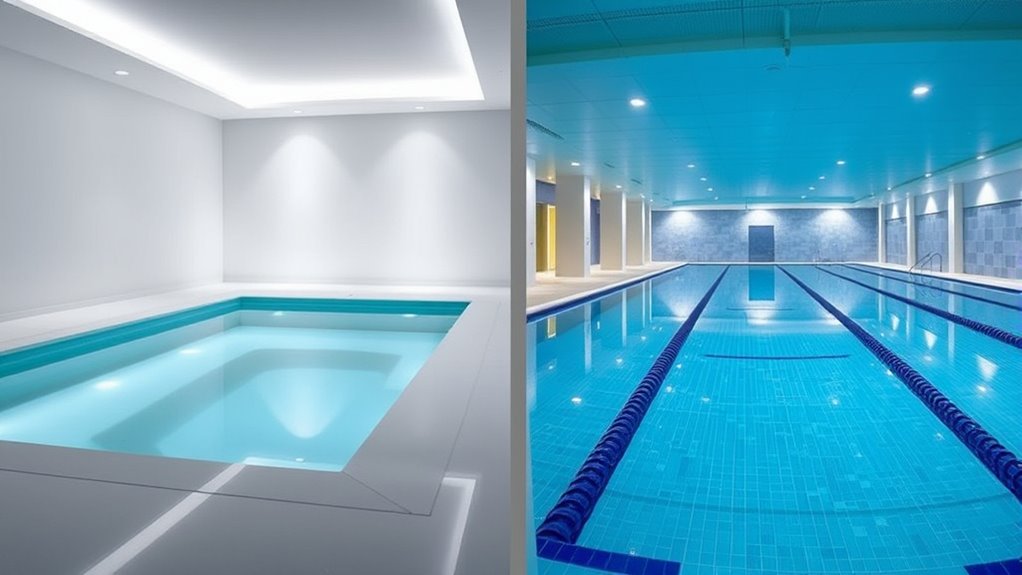
To choose the right pool, consider your space, budget, and how you plan to use it. Think about whether you need a compact option for fitness or a larger one for recreation. Your decision should align with your specific needs and lifestyle priorities. Additionally, exploring different pool features & accessories can enhance your pool experience and functionality.
Space Availability Considerations
When deciding between an endless pool and a lap pool, evaluating your available space is vital. Your yard or indoor area will determine which option fits best. Consider these key factors:
- Size constraints: Measure your space carefully to ensure the pool fits comfortably without overcrowding.
- Shape flexibility: Endless pools often adapt to smaller or irregular spaces, while lap pools typically require a long, narrow area.
- Installation requirements: Some pools need additional clearance for maintenance or accessories, influencing your layout choices.
Fitness and Recreation Goals
Your fitness and recreation goals play a crucial role in choosing the right pool. If your main goal is to swim laps and improve endurance, a lap pool is ideal because of its length and dedicated space for continuous swimming. It allows for structured workouts and tracking progress over longer distances. On the other hand, if you want a versatile, low-impact exercise option that also offers relaxation and fun, an endless pool suits your needs better. Its smaller size makes it perfect for various water activities, resistance training, or casual swimming. Consider whether your focus is on structured workouts or recreational enjoyment. Your goals will determine which pool type provides the most value, helping you make a confident decision that aligns with your lifestyle and desired outcomes.
Maintenance and Budget Needs
While both endless pools and lap pools require ongoing maintenance, their costs and complexity can differ markedly, impacting your overall budget. Endless pools often have simpler systems, leading to lower maintenance costs. In contrast, lap pools, especially larger or in-ground ones, may need regular cleaning, chemical balancing, and equipment upkeep, which can add up.
Consider these factors:
- Initial Investment – Endless pools are usually less expensive to install than in-ground lap pools.
- Ongoing Costs – Maintenance, chemicals, and electricity tend to be lower for endless pools.
- Long-Term Expenses – Repairs and upgrades for traditional lap pools can be more costly over time.
Your decision should balance upfront costs with ongoing expenses based on your financial comfort.
Frequently Asked Questions
How Long Does It Take to Install Each Pool Type?
It typically takes about 1 to 2 days to install an Endless Pool, thanks to its compact, plug-and-play design. In contrast, a traditional lap pool usually requires 1 to 3 weeks, depending on size and site preparation. You can expect quicker setup with an Endless Pool, making it ideal if you want fast installation. However, a lap pool offers more customization but takes longer to complete.
Can These Pools Be Used Indoors and Outdoors?
Imagine a canvas that transforms with your needs—these pools do just that. You can use both indoors and outdoors, depending on your space and climate. An indoor pool becomes a sanctuary, a private retreat, while outdoor use connects you with nature’s rhythm. Whether you want the serenity of indoor waters or the invigorating splash of outdoor swimming, these pools adapt, making your aquatic dreams a versatile reality.
What Safety Features Are Available for Each Pool?
Both pools offer essential safety features like non-slip surfaces, sturdy handrails, and secure covers. Endless pools often include automatic shut-off systems and safety alarms, while lap pools can have pool alarms and fencing options. You can also add childproof covers and alarms for extra security. Check each model’s specifications to guarantee they meet your safety needs, making your swimming experience safer for everyone.
Are There Options for Heating or Cooling These Pools?
Yes, you can heat or cool both pools to suit your preferences. Many Endless Pools offer built-in heaters, allowing you to enjoy warm water year-round. Lap pools can also be equipped with heating and cooling systems, giving you control over water temperature. This guarantees comfort during workouts or relaxation, no matter the season. So, whether you want to swim in warm or cool water, both options can meet your climate needs.
How Do Maintenance Needs Differ for Indoor Versus Outdoor Pools?
Indoor pools typically require less maintenance because they’re protected from the elements, reducing debris and chemical evaporation. You’ll need to regularly check and balance water chemistry, clean filters, and monitor humidity levels to prevent mold. Outdoor pools, on the other hand, face more debris, algae growth, and weather-related wear, so they need frequent skimming, chemical adjustments, and cover use. Both pools demand consistent upkeep, but outdoor pools generally demand more frequent attention.
Conclusion
As you stand by your backyard, imagining a sleek endless pool seamlessly blending into your space or a compact lap pool inviting daily laps, it’s clear both options suit different lifestyles. Whether you’re drawn to endless hours of relaxation or focused on fitness, your perfect fit emerges as naturally as the sunlight reflecting on calm water. Trust your instincts—your ideal pool is waiting, ready to turn everyday moments into a revitalizing escape.

